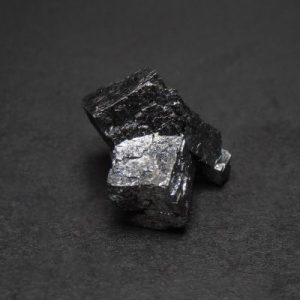Acanthite
Acanthite is a silver sulfide mineral and is one of the most important ores of Silver. Acanthite was named in 1855 by Gustav Adolf Kenngott from the Greek word akantha meaning thorn, in allusion to its crystal shape. The name Acanthite is often confused with or used interchangeably with Argentite. Acanthite and Argentine have the same chemistry, Ag2S, but different structures. Acanthite is the low-temperature form of Argentine. Acanthite has a monoclinic structure and is stable below 173 degrees Celsius while Argentite has an isometric structure and is only stable at temperatures above 173 degrees Celsius. All natural silver sulfide specimens (and gems) at room temperature are Acanthite. The tarnish on sterling silver is chemically the same as Acanthite.
Acanthite was named in 1855 by German mineralogist Gustav Adolf Kenngott (1818-1897) from the Greek wordάκανθα (ákantha) meaning thorn, in allusion to its crystal shape. It was discovered in the Jáchymov District, Krušné Hory Mts, Karlovy Vary Region, Bohemia, Czech Republic.
Acanthite distribution: widespread in silver deposits. Localities for fine primary and paramorphic crystals include: from Jáchymov (Joachimsthal), Czech Republic [TL]. In Germany, at Freiberg, Schneeberg, Annaberg, and Marienberg, Saxony; and from St. Andreasberg, Harz Mountains. In Mexico, large paramorphs from Arizpe, Sonora; in the Rayas and other mines at Guanajuato; and from many mines in Zacatecas, Chihuahua, etc. In the USA, at Butte, Silver Bow County, Montana; Tonopah, Nye County, and the Comstock Lode, Virginia City, Storey County, Nevada. From various mines at Cobalt, Ontario, Canada. At Chañarcillo, south of Copiapó, Atacama, Chile.
| Chemical Formula: | Ag2S |
| Silver Sulfide | |
| Molecular Weight: | 247.80 gm |
| Composition: | Silver | 87.06 % | Ag | ||
| Sulfur | 12.94 % | S | |||
| 100.00 % |
| Crystallography: | Monoclinic – Prismatic |
| Crystal Habit: | Primary crystals are rare, prismatic to long prismatic, elongated along [001], to 2.5 cm, may be tubular; massive. Commonly paramorphic after the cubic high-temperature phase (“argentite”), of original cubic or octahedral habit, to 8 cm. |
| Twinning: | Polysynthetic on {111}, may be very complex due to inversion; contact on {101} |
| Color: | Lead grey, iron black |
| Hardness: | 2.0 – 2.5 |
| Transparency: | Opaque |
| Luster: | Metallic |
| Birefringence: | n/a (opaque) |
| Dispersion: | n/a |
| Pleochroism: | n/a |
| Anisotropism: | Weak |


